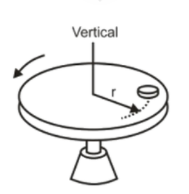A gramophone disc rotates at 60 rpm. A coin of mass 18 g is placed at a distance of 8 cm from the centre. Calculate the centrifugal force on the coin. Take π2=9.87.
Step by step video & image solution for A gramophone disc rotates at 60 rpm. A coin of mass 18 g is placed at a distance of 8 cm from the centre. Calculate the centrifugal force on the coin. Take pi^(2) = 9.87. by Physics experts to help you in doubts & scoring excellent marks in Class 11 exams.
Updated on:21/07/2023Topper's Solved these Questions
Similar Questions
A gramophone disc rotates at 60 rpm . A coin of mass 18 g is placed at a distance of 8 cm from the centre . Calculate centrifugal force on the coin . Take π2=9.87 .
View SolutionA disc starts rotating with a constant angular acceleration of 1rad/s2 about a fixed vertical axis perpendicular to its plane and passing through its centre. A coin of mass 10gm is placed on the disc at a distance of 10cm from the axis. The coefficent of friction between the disc and the coin is 0.2. The value of the frictional force on the coin at t=1s will be
View Solution
Knowledge Check
A gramophone disc rotates with a uniform angular velocity of 6rad/s . A coins of mass 2 gm is placed 5 cm from the centre .The centripetal force acting on the coin is
A3.6 dynesB36 dynesC360 dynesD3600 dynesA coin kept on a rotating gramophone disc just beging to slip if its centre is at a distance of 8 cm from the centre of the disc .The angular velocity of the gramophone disc is then doubled , Through what distance , the coin should be shifted towards the centre , so that the coin will just slip ?
A2 cmB4 cmC6 cmD16 cmA coin placed on a rotating gramophone disc, remains at rest when it is at a distance of 9 cm from its centre ,the angular velocity of the disc is then tripled .At what distance from the centre ,the coin should be placed , so that it will remain at rest ?
A2cmB1 cmC3 cmD6 cm
A small coin of mass 40 g is placed on the horizontal surface of a rotating disc. The disc starts from rest and is given a constant angular acceleration α=2 rad s−2. The coefficient of static friction between the coin and the disc is μs=3/4 and the coefficient of kinetic friction is μk=0.5. The coin is placed at a distance r=1m from the centre of the disc. The magnitude of hte resultant force on the coin exerted by the disc just before it starts slipping on the disc is :

View SolutionA small coin of mass 80g is placed on the horizontal surface of a rotating disc. The disc starts from rest and is given a constant angular acceleration α=2rad/s2. The coefficient of static friction between the coin and the disc is μs=3/4 and cofficient of kinetic friction is μk=0.5. The coin is placed at a distance r=1m from the centre of the disc. The magnitude of the resultant force on the coin exerted by the disc just before it starts slipping on the disc is

View SolutionA coin just remains on a disc rotating at a steady rate of 180r.p.m .A coin is kept at a distance of 2 cm from the axis of rotationn . The coefficient of fricition between the coin and the disc is _____ [gg=9.8m/s2]
View SolutionA coin placed on a rotating turn table just slips if it is placed at a distance of 8 cm from the centre. If angular velocity of the turn table is doubled . It will just slip at a distance of
View SolutionA coin placed on a rotating turntable just slips if it is placed at a distance of 16 cm from the centre. If the angular velocity of the turnable is doubled, it will just slip at a distance ( in cm) of
View Solution
